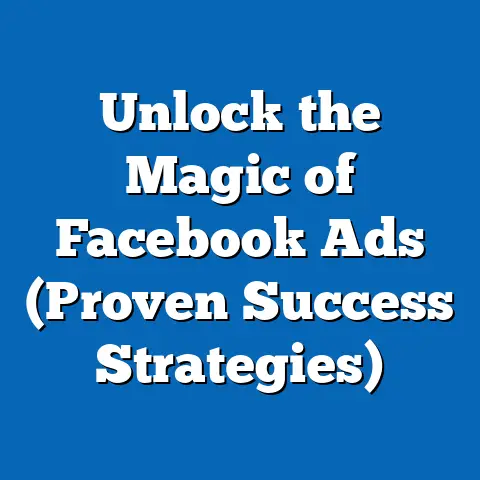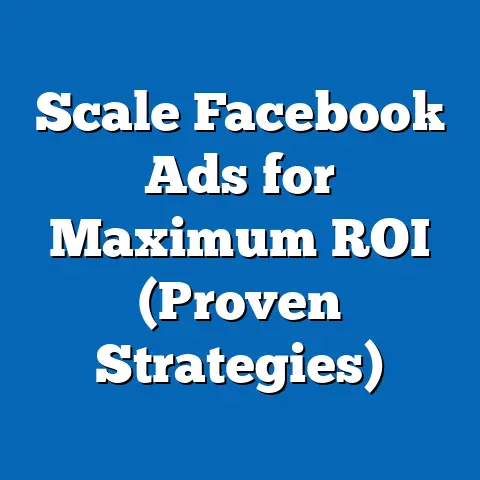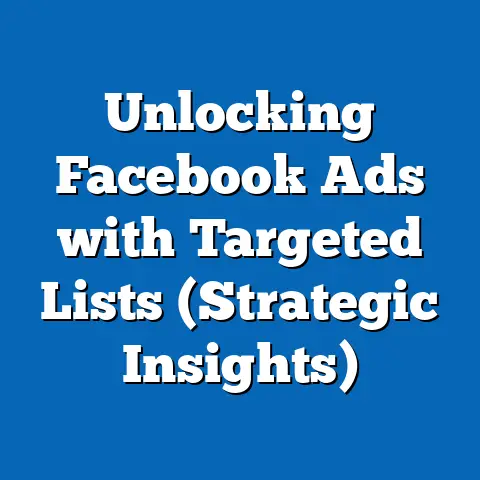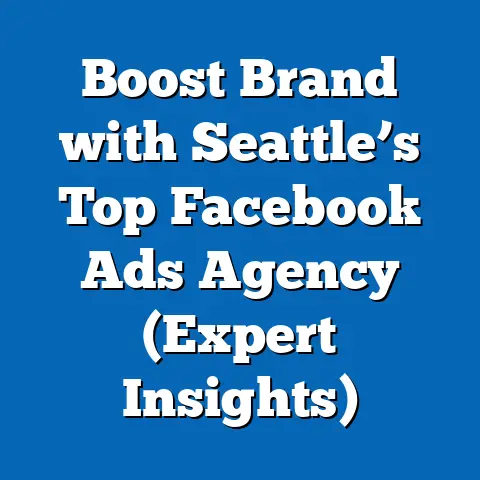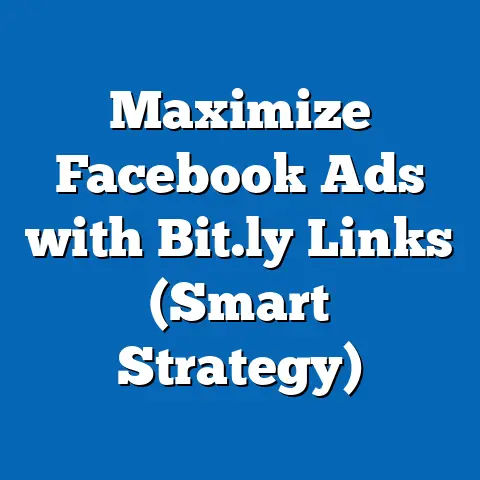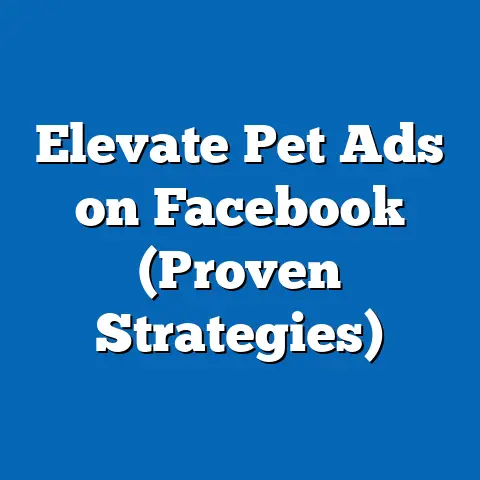Elevate Facebook Ads Strategy (Expert Insights Inside)
Facebook Ads, a powerhouse in the digital marketing realm, often feels like a riddle wrapped in an enigma. We all know it can work, but consistently achieving breakthrough results? That’s where the “secret sauce” comes in. Too often, I see businesses treating Facebook Ads as a simple plug-and-play solution, missing out on the deeper strategies that drive exponential growth. They dabble in basic targeting, create generic ads, and then wonder why their ROI is lackluster.
But what if I told you there are insights and strategies that only the top industry experts know, secrets they’ve honed through years of experience and countless campaigns? How can these secrets transform your advertising approach and yield impressive results?
This isn’t about magic tricks or overnight success. It’s about understanding the nuances of the platform, leveraging data intelligently, and crafting compelling experiences that resonate with your target audience. In this guide, I’m going to pull back the curtain and reveal some of those best-kept secrets, empowering you to elevate your Facebook Ads strategy from good to truly exceptional. So, buckle up, and let’s dive into the world of Facebook Ads mastery!
Understanding the Fundamentals of Facebook Ads
Before we start discussing expert-level strategies, I want to make sure we’re all on the same page with the fundamentals. Think of it like building a house – you need a solid foundation before you can add the fancy fixtures. The core components of Facebook Ads are:
- Targeting: Defining who you want to see your ads. This involves demographics, interests, behaviors, and connections.
- Ad Formats: Choosing the right type of ad, whether it’s a single image, video, carousel, or collection ad.
- Budgeting: Deciding how much you’re willing to spend on your campaign and how that budget is allocated.
- Bidding: Selecting a bidding strategy, whether it’s automatic bidding that lets Facebook optimize for you, or manual bidding where you set your own bid amounts.
- Ad Copy & Creative: Creating compelling text and visuals that grab attention and persuade people to take action.
Understanding these fundamentals is absolutely crucial before diving into advanced strategies. It’s like learning the alphabet before writing a novel. If you skip the basics, you’ll struggle to understand why your campaigns aren’t performing as expected.
According to Statista, Facebook’s advertising revenue reached nearly $117 billion in 2022. That’s a HUGE number, and it highlights the effectiveness of Facebook Ads when done right. However, I’ve seen firsthand how many marketers overlook these basics, setting themselves up for failure. They might have a great product or service, but without a solid understanding of targeting, budgeting, and ad creative, their message gets lost in the noise.
Key Takeaway: Master the fundamentals of Facebook Ads before diving into advanced strategies. It’s the foundation upon which all successful campaigns are built.
Expert Insights on Targeting Audiences
Okay, let’s get to the good stuff: the first “secret” to a killer Facebook Ads campaign lies in laser-focused audience targeting. I cannot stress this enough: your ad, no matter how brilliant, is useless if it’s shown to the wrong people.
Here’s the thing: Facebook offers a treasure trove of targeting options, but many advertisers barely scratch the surface. They rely on broad interests or basic demographics, missing out on the power of precise audience segmentation.
Here are some expert-approved strategies for audience segmentation:
- Lookalike Audiences: This is where Facebook finds people who are similar to your existing customers or website visitors. I’ve personally seen lookalike audiences outperform interest-based targeting by a significant margin, especially when using a high-quality source audience (like a list of your top customers).
- Custom Audiences: These are audiences you create based on your own data, such as email lists, website traffic, or app activity. Custom audiences allow you to re-engage with people who have already shown interest in your business, making them more likely to convert.
- Interest-Based Targeting: While broad interest targeting can be ineffective, it can be powerful when combined with other targeting options. Think about layering interests to narrow down your audience. For example, targeting people interested in “yoga” AND “organic food” can be more effective than targeting people interested in “yoga” alone.
- Behavioral Targeting: This allows you to target people based on their online behavior, such as purchase history, device usage, or travel habits. This can be incredibly powerful for reaching specific niches or identifying potential customers who are actively looking for your product or service.
Real-World Example: I once worked with a local bakery that was struggling to attract new customers. They were running ads targeting everyone in their city who liked “baking.” We decided to create a custom audience of people who had visited their website in the past month and a lookalike audience based on their existing customer list. The results were dramatic. Their ad spend remained the same, but their website traffic increased by 150%, and their in-store sales jumped by 30%.
Emerging trends in audience targeting include:
- Privacy-Focused Targeting: With increasing concerns about data privacy, Facebook is offering more privacy-safe targeting options, such as aggregated audiences and privacy-preserving measurement.
- AI-Powered Targeting: Facebook is using artificial intelligence to improve audience targeting and ad delivery. This includes features like Advantage+ audience, which uses AI to automatically find the best audience for your ads.
To adapt to these changes, experts recommend:
- Focusing on First-Party Data: Building your own email list and customer database is more important than ever.
- Testing Different Targeting Options: Continuously experiment with different audience segments to see what works best for your business.
- Staying Up-to-Date with Facebook’s Policies: Facebook’s advertising policies are constantly evolving, so it’s important to stay informed and adapt your strategies accordingly.
Key Takeaway: Don’t settle for broad targeting. Invest time in creating precise audience segments that align with your ideal customer profile. Leverage lookalike audiences, custom audiences, and layered interest-based targeting to maximize your ad performance.
Creative Ad Formats and Copywriting Secrets
Now that you’ve nailed your targeting, let’s talk about the creative side of Facebook Ads: choosing the right ad format and crafting compelling ad copy.
Think of your ad as a tiny billboard vying for attention in a crowded digital landscape. You have just a few seconds to grab someone’s attention and convince them to take action. This is where creativity and strategic copywriting come into play.
Here’s a rundown of popular ad formats and how to use them effectively:
- Single Image Ads: These are the simplest ad format, but they can still be highly effective with a captivating image and concise copy.
- Video Ads: Video is incredibly engaging and can be used to tell a story, showcase your product, or provide valuable information.
- Carousel Ads: These allow you to showcase multiple products or features in a single ad. They’re great for e-commerce businesses or highlighting different aspects of your brand.
- Collection Ads: These are designed for mobile shopping and allow users to browse and purchase products directly from the ad.
- Lead Ads: These are designed to generate leads by collecting contact information directly within the ad. They’re great for building your email list or gathering information about potential customers.
Choosing the right format depends on your marketing goals and your target audience. For example, if you’re trying to build brand awareness, video ads might be the best option. If you’re trying to drive sales, carousel ads or collection ads might be more effective.
Expert Tip: Don’t be afraid to experiment with different ad formats to see what resonates with your audience. A/B testing is your best friend here.
Now, let’s talk about crafting compelling ad copy. Here are some expert tips:
- Know Your Audience: Speak their language, address their pain points, and offer them a solution.
- Use Storytelling: People are naturally drawn to stories. Use storytelling to connect with your audience on an emotional level and make your ad more memorable.
- Highlight Benefits, Not Just Features: Focus on how your product or service will improve their lives. What problem does it solve? What value does it provide?
- Create a Sense of Urgency: Use words like “limited time offer” or “act now” to encourage people to take action.
- Include a Clear Call-to-Action (CTA): Tell people exactly what you want them to do, whether it’s “Learn More,” “Shop Now,” or “Sign Up.”
Example of a Successful Ad: I recently saw an ad for a language learning app that used storytelling effectively. The ad featured a short video of a person traveling in a foreign country, effortlessly conversing with locals. The ad copy highlighted the benefits of learning a new language, such as experiencing new cultures and connecting with people from around the world. The CTA was “Start Your Free Trial.” This ad was highly engaging and made me want to download the app immediately.
A/B testing is crucial for refining your ad creatives and copy. Test different headlines, images, videos, and CTAs to see what performs best. Use Facebook’s A/B testing tool to run controlled experiments and gather data-driven insights.
Key Takeaway: Choose the right ad format based on your marketing goals and target audience. Craft compelling ad copy that resonates with your audience, highlights benefits, and includes a clear call-to-action. Continuously A/B test your creatives and copy to optimize for performance.
The Power of Retargeting and Conversion Optimization
Let’s face it: most people don’t buy something the first time they see an ad. They need to be nurtured and reminded of your product or service. This is where retargeting comes in.
Retargeting allows you to show ads to people who have already interacted with your business, such as visiting your website, watching a video, or adding an item to their cart. It’s like giving them a gentle nudge to complete the purchase or take the next step.
Retargeting can significantly boost conversion rates by re-engaging potential customers. According to a study by Criteo, retargeting ads have a 10x higher click-through rate than regular display ads.
Here are some expert tips on creating effective retargeting campaigns:
- Segment Your Retargeting Audiences: Don’t show the same ad to everyone. Segment your audience based on their behavior and show them personalized ads that are relevant to their interests. For example, show different ads to people who visited your product page versus those who added an item to their cart.
- Use Dynamic Product Ads: These ads automatically show people the products they viewed on your website. They’re highly effective for driving sales and reminding people of what they were interested in.
- Limit Ad Frequency: Don’t bombard people with too many ads. This can be annoying and counterproductive. Experiment with different ad frequencies to find the sweet spot.
- Personalize Your Messaging: Use personalized messaging that addresses their specific needs and interests. For example, if someone abandoned their cart, show them an ad that offers free shipping or a discount.
Real-World Example: An e-commerce client I worked with saw a significant increase in sales after implementing retargeting campaigns. They segmented their audience based on their website behavior and showed them personalized ads with dynamic product recommendations. They also offered a discount code to people who abandoned their carts. As a result, their conversion rate increased by 40%, and their ROI doubled.
Conversion optimization techniques are also crucial for maximizing the effectiveness of your Facebook Ads. This involves optimizing your landing pages, ad copy, and overall customer experience to increase the likelihood of people taking the desired action.
Here are some key conversion optimization techniques:
- Landing Page Optimization: Ensure your landing pages are relevant to your ads, load quickly, and have a clear call-to-action.
- A/B Testing: Continuously test different elements of your landing pages, such as headlines, images, and CTAs, to see what performs best.
- Mobile Optimization: Make sure your website and landing pages are optimized for mobile devices.
- Tracking Metrics That Matter: Track key metrics like conversion rate, cost per conversion, and return on ad spend (ROAS) to measure the effectiveness of your campaigns.
Key Takeaway: Retargeting is a powerful tool for re-engaging potential customers and boosting conversion rates. Segment your retargeting audiences, use dynamic product ads, and limit ad frequency. Implement conversion optimization techniques to maximize the effectiveness of your Facebook Ads.
Leveraging Data Analytics for Continuous Improvement
Finally, the last “secret” to Facebook Ads success is data analytics. I often tell my clients that running Facebook Ads without analyzing the data is like driving a car blindfolded. You might get somewhere, but you’re more likely to crash.
Data analytics allows you to understand how your campaigns are performing, identify areas for improvement, and make data-driven decisions. It’s the key to continuous improvement and maximizing your ROI.
Key performance indicators (KPIs) that experts recommend tracking include:
- Reach: The number of unique people who saw your ads.
- Impressions: The number of times your ads were displayed.
- Click-Through Rate (CTR): The percentage of people who clicked on your ads.
- Conversion Rate: The percentage of people who took the desired action after clicking on your ads.
- Cost Per Conversion: The cost of acquiring one conversion.
- Return on Ad Spend (ROAS): The revenue generated for every dollar spent on advertising.
Facebook Ads Manager provides a wealth of data and analytics that you can use to track your campaign performance. You can also use third-party tools like Google Analytics or Supermetrics to get a more comprehensive view of your data.
Here are some insights on using data analytics to pivot your strategies and achieve better results:
- Identify Underperforming Ads: Analyze your data to identify ads that have low CTR or conversion rates. Pause or modify these ads to improve their performance.
- Optimize Your Targeting: Analyze your data to see which audience segments are performing best. Focus your efforts on these segments and refine your targeting to reach more people like them.
- Improve Your Ad Creatives: Analyze your data to see which ad creatives are generating the most engagement and conversions. Use these insights to create more effective ad creatives.
- Adjust Your Bidding Strategy: Analyze your data to see if you’re overpaying for clicks or conversions. Adjust your bidding strategy to optimize for cost-effectiveness.
Real-World Example: I once worked with a client who was running Facebook Ads to promote their online course. They were getting a lot of clicks, but their conversion rate was low. After analyzing their data, we discovered that most of their traffic was coming from mobile devices, but their landing page wasn’t optimized for mobile. We optimized their landing page for mobile devices, and their conversion rate increased by 50%.
Key Takeaway: Data analytics is essential for understanding how your Facebook Ads are performing and making data-driven decisions. Track key performance indicators, analyze your data, and use the insights to pivot your strategies and achieve better results.
Conclusion
So, there you have it: the best-kept secrets of Facebook Ads, revealed! From laser-focused targeting to compelling ad creatives, effective retargeting, and data-driven optimization, these strategies can transform your advertising approach and yield impressive results.
I encourage you to implement at least one of these strategies in your next Facebook Ads campaign and see the tangible improvements for yourself. Whether it’s creating a lookalike audience, crafting more compelling ad copy, or optimizing your landing pages, every little bit counts.
Remember, Facebook Ads is not a set-it-and-forget-it platform. It requires continuous learning, experimentation, and adaptation. But with the right knowledge and strategies, you can unlock its full potential and achieve your marketing goals.
The best-kept secrets are now within your reach, waiting to be utilized for your marketing success. Go out there and make it happen! I’m excited to see the amazing results you achieve!

